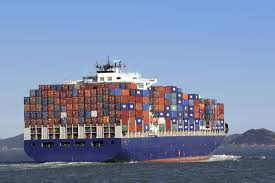
We’ve been talking about it for a little while now. The Los Angeles Times calls it a “logistical nightmare”. Claims Journal calls it the Ports of Los Angeles and Long Beach’s “biggest crisis in a decade”. What we’re talking about is the congestion at the Southern California ports, which happen to handle approximately 40% of U.S. imports.
Our blog has looked at the causes of the congestion:
5 Factors Causing Congestion at the Ports of L.A. and Long Beach
We’ve looked at how the congestion is affecting shippers and the direction the problem is trending in with:
Congestion at Ports of L. A. & Long Beach Getting Worse, Not Better
We’ve even looked at a move the Port of Long Beach has made to alleviate the problem and prevent future repeats of this same congestion issue:
Port of Long Beach Getting Chassis to Alleviate Congestion
What we haven’t looked at are the container ships that have been sitting idle, waiting to unload their cargo. Of course, all it takes is looking out at the Pacific Ocean off the Ports of Los Angeles and Long Beach to do so.
Grace M. Lavigne reported in the Journal of Commerce earlier this week:
Eleven container ships were anchored off the ports of Los Angeles and Long Beach on Sunday, the most waiting at one time in San Pedro Bay in two years, as gridlock persisted at the largest container gateway in the Americas.
The queue dipped to nine on Monday, down from 10 on Saturday and 11 on Sunday but up from seven on Friday, according to the Marine Exchange of Southern California. Last week, the high was on Tuesday, Oct. 21, with eight ships at anchor.
A quote in a Lavigne JOC story from last week helps illuminate the enormity of port congestion causing container ship backups:
“This is very unusual,” [retired Coast Guard Capt. J. Kipling “Kip”] Louttit said. “There’s usually zero wait times with container ships. The only time a container ship is usually at anchor is if something weird happens: a breakdown, a casualty or a Coast Guard holdup. Container ships normally run on rails.”
The port congestion problem at Los Angeles and Long Beach is hurting everyone involved in international shipping. Truckers are spending whole days to get a single shipment out of ports, an impossible situation for making profit. Ship delays cost carriers money. And, of course, shippers get hit with fees from the carriers and truckers while suffering delays on getting their cargo.
The feelings of frustration at the situation seem to be universal. Here are a few quotes from an L.A. Times article by Andrew Khouri on the situation:
“We have a meltdown on the harbor,” said Robert Curry, president of California Cartage Co….
“This is an important time and we need fully functioning ports to make sure goods get to the store shelves,” said Jon Gold, vice president of supply chain and customs policy at the National Retail Federation….
“This is really a perfect storm,” said Port of Los Angeles Executive Director Gene Seroka….
This is not the first time container ship backups have been seen at the Ports of Los Angeles and Long Beach. Lavigne’s JOC article reports:
The last time congestion at the Southern California ports was this severe was when striking office clerical workers crippled the ports in the fall of 2012, Louttit said. The clerk’s strike led to a peak of 30 container ships sitting at anchor at one point, he said….
Congestion at the Southern California ports was also significant in 2004, when Union Pacific Railroad was not adequately staffed to handle the peak season that year, resulting in 65 ships at anchor or steaming offshore, plus 127 ships that diverted to other ports, Louttit said. Other severe episodes occurred in 2002, when the Pacific Maritime Association locked out International Longshore and Warehouse Union dockworkers for 10 days, causing about 30 ships to be anchored at one time with 14 diverted to other ports; and following the 9/11 attacks in 2001, when there were about 25 to 30 ships at anchor, he said.
A large factor in the current backups is high numbers in container ships and cargo volume currently going to the ports. Improving economy and a peak season starting earlier and surging later due to fears of slowdowns or shutdowns because of ILWU contract negotiations contribute to those high container ship and cargo volume numbers.
Perhaps there can be some irony found in shippers prudently adjusting import schedules to avoid possible port delays only to have that trend help increase port delays.
Of course, shippers cannot be blamed for the congestion happening at the ports. The root problems are chassis management and availability, ship sizes, and trucker shortages. Unfortunately, shippers are often the ones having to pay the biggest price, no matter whose fault the problems are.
